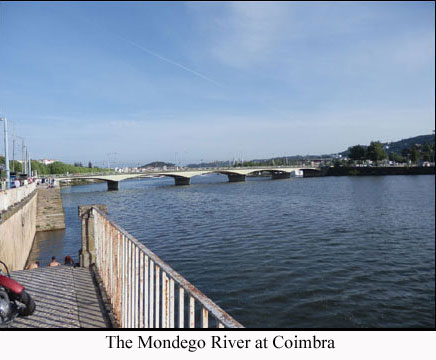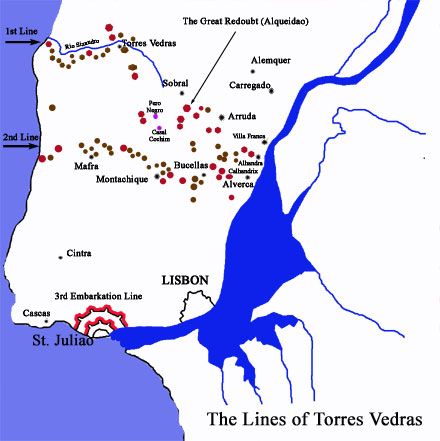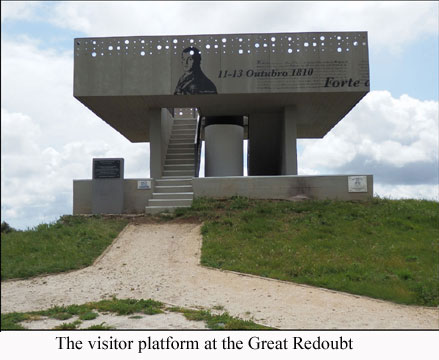
Chapter 30
Wellington's
Retreat to the Lines of Torres Vedras
Sept - Nov 1810
See
'Lines' Plan
On 28th
September, Massena took the road from Mortagoa via Boialvo
to Sardao and on to the Oporto to Lisbon road. Early on
the 29th Wellington began withdrawing from Busaco with
the right wing under Hill heading for Espinhal and Thomar
and the centre and left wing heading for Mealhada and
Coimbra with the Light Division,
Pack’s brigade and Anson’s cavalry remaining
as a rear guard. Despite Wellington’s requests,
Coimbra and the countryside around had not been evacuated
and on the approach of the French, the population belatedly
fled in panic blocking the bridges and roads. |
 |
The Light Division
remained to the north of Coimbra defending the city whilst
the residents began belatedly to evacuate and move south
on the 30th September. When the French finally arrived
in the city they halted in their pursuit and plundered
the available provisions, since most had been on short
rations for some time. They stayed in the city for 2 days,
giving Wellington’s army a head start whilst retreating
along 3 roads south, Hill and the 2nd Division took the
Thomar – Santarem – Villa Franca road, Picton
and the 3rd Division the Alcobaca – Caldas –
Torres Vedras road and Spencer, Leith and Cole with the
1st 4th and 5th Divisions took the Leira – Batalha
– Alemquer road with the rear guard of Crauford
and Pack following Spencer a days march behind and Anson’s
light cavalry bringing up the extreme rear. The weather
broke on the 8th October making movements more difficult
which hampered the French more than the allies as on the
9th the army moved into the Lines followed by the cavalry
on the 10th, leaving Crauford and |
Pack
outside the Lines at Alemquer where there was a brief
skirmish, and were forced to retreat towards Sobral from
whence Crauford entered the lines and Pack was ordered
to put himself under the command of Spencer who was occupying
the village.
On the
11th Massena’s advance infantry (Montbrun) approached
Sobral. The next day (12th ) Pack was ordered to:
“..occupy the
villages of Cagaes, Malgas and Montelhas, to be in readiness
to move into the redoubts at short notice.” |
The disposition
of Wellington’s army along the Lines of Torres Vedras
in October 1810 was as follows: The 2nd Division were
stationed at Alhandra; Hamilton’s Portuguese at
Villa Franca; the Light Division from the west of Alhandra
to Monte Agraco; the 5th Division to the rear of Mount
Agraco; Pack’s Portuguese Brigade placed in the
Great Redoubt on Mount Agraco;
the 1st and 4th Divisions occupying the districts between
Mount Agraco and Torres Vedras; the 3rd Division occupied
Torres Vedras and watched the line
of the Zizandre river. In addition, there was a special
independent force under General Sontag comprised of the
58th Regiment and two regiments of Portuguese militia,
to occupy Torres Vedras and the redoubts from there to
the sea, in addition to Picton’s 3rd Division. Massena
adopted an aggressive stance in front of the lines with
Junot’s VIII Corps at Sobral, just 1 mile in front
of the Great Redoubt; Reynier had II Corps at Carregado
with his outposts at Vila Franca; Ney was placed between
Junot and Reynier with a brigade of VI Corps opposite
Arruda and the remainder to the rear at Otta and Alemquer;
the artillery and cavalry reserves were at Santarem 20
miles to the north on the banks of the Tagus. On the night
of the 12th/13th |
 |
Wellington became convinced that the French
at Sobral were the greatest threat and so concentrated
his forces at that point in the line and placed Pack in
command of the Great Redoubt on Mount Agraco which lies
just to the south of Sobral. The Great Redoubt was the
biggest in the Lines and from it the whole line could
be viewed on a clear day from the Tagus to the sea. There
was some serious skirmishing in front of Sobral on the
13th and 14th but Massena became convinced that |
 |
Wellington’s
positions were too strong to overcome. It is worth noting
here that the French position was made more precarious
on the 9th October when Trant in charge of the Portuguese
militia attacked Coimbra from the north and took 5,000
French prisoners as well as his depots and hospitals.
Wellington established his headquarters at a large country
house in the village of Pero Negro
not far from the Great Redoubt and within a kilometre
of Casa Cochim where Beresford established
his headquarters, in fact the two buildings were within
sight of each other. The villages where Pack’s Independent
Portuguese Brigade was cantoned (Cagaes, Malgas and Montelhas)
were also close by. Wellington required the garrisons
in the redoubts on the Lines to ‘stand to’
2 hours before dawn and to remain so until he had ridden
to the Great Redoubt and studied the enemy positions.
Once he was satisfied that their positions had not changed,
they were allowed to stand down. A signalling system had
been established across the Lines |
| capable
of transmitting a message across the 29 miles from the
Tagus river to the sea in just 7 minutes. Crauford had
clearly been pressing Wellington to reinforce his Light
Division but Wellington was concerned that to do so might
lead to more senior officers claiming his command and
he was keen to keep Crauford where he was, as this letter
from Wellington shows:
To General Crauford
Pero Negro 12th November 1810
“I have been thinking for some time of reinforcing
your Division, and you will see what I have been able
to do in this way today. The truth is that if I should
make you as strong as I could wish, there will be other
claimants for the command of the Division; and I think
it much better to keep a Portuguese Brigade in reserve
and unattached, to be attached to you when it is necessary
to reinforce you, than to place one permanently under
your command which would give claims to others.”
It is obviously Pack’s
Independent Portuguese Brigade to which Wellington is
referring.
|
Maps
Photos

|





